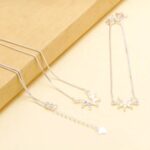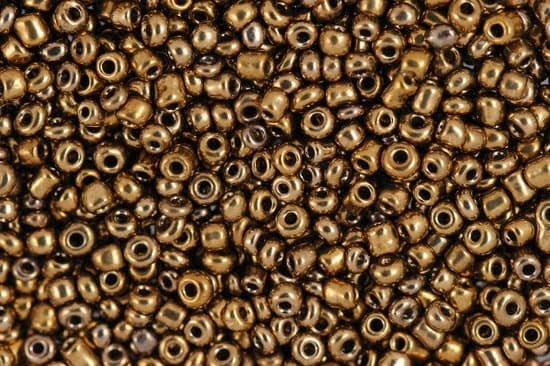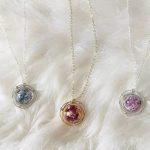Tarnished jewelry can be a frustrating problem for those who want to keep their accessories sparkling and beautiful. Whether it’s a treasured silver necklace or a favorite gold ring, tarnish can quickly dull the shine and luster of any piece. In this article, we will explore the common issue of tarnished jewelry, why it occurs, and the importance of keeping our beloved pieces clean and shiny.
Tarnish is a natural process that occurs when certain metals react with oxygen or other substances in the air. It can manifest as a thin film or layer over the surface of jewelry, resulting in a dull, discolored appearance. This tarnish can not only affect the aesthetic appeal of our jewelry but also weaken its overall structure if left untreated.
Keeping our jewelry clean and free from tarnish is essential to ensure its longevity and maintain its value. Regular cleaning not only restores its brilliance but also helps prevent further tarnishing. Additionally, clean jewelry enhances our overall style and boosts our confidence when wearing them.
In the following sections, we will delve into different types of tarnish that can affect jewelry, explore common household items that can effectively clean tarnished pieces, discuss commercial cleaning solutions available in the market, present DIY methods recommended by experts, and even look into professional jewelry cleaning services. We will also provide preventive measures to avoid tarnish build-up and specific advice on caring for different types of jewelry.
So let’s dive in and learn how to keep our cherished accessories sparkling and tarnish-free.
Understanding the Different Types of Tarnish
Tarnish is a common issue that affects jewelry, causing it to lose its shine and luster over time. Understanding the different types of tarnish can help you effectively clean and prevent further damage to your precious pieces. There are various types of tarnish that can affect jewelry, including oxidation tarnish and sulfur tarnish.
Oxidation tarnish occurs when metals react with oxygen in the air or water, resulting in a dull and darkened appearance. This type of tarnish is commonly seen on silver jewelry. On the other hand, sulfur tarnish forms when metals come into contact with sulfur-containing substances like eggs, rubber bands, or certain cosmetics. Sulfur tarnish often appears as a black film or residue on the surface of the jewelry.
To differentiate between these types of tarnishes, look for specific characteristics and appearances. Oxidation tarnish usually appears as a darkened layer that covers the entire piece of jewelry. It may also have a yellow or green tinge in some cases. Sulfur tarnish, on the other hand, may appear localized in areas where it has come into contact with sulfur-containing substances.
When it comes to cleaning different types of tarnished jewelry, it’s important to use appropriate methods and cleaning solutions based on the type of tarnish involved. While common household items such as vinegar and baking soda can be effective in removing both oxidation and sulfur tarnishes, each method requires specific steps to achieve optimal results.
Here are step-by-step instructions for cleaning oxidation-tarnished silver jewelry using vinegar:
- Create a solution by mixing equal parts white vinegar and water.
- Place your silver jewelry into the solution and let it soak for about 2-3 hours.
- Gently scrub the jewelry using a soft-bristle toothbrush to remove any remaining tarnish.
- Rinse the jewelry thoroughly with clean water.
- Dry the jewelry using a soft cloth.
For sulfur-tarnished jewelry, using baking soda can be an effective method:
- Create a paste by mixing 2-3 tablespoons of baking soda with enough water to form a thick consistency.
- Apply the paste onto the tarnished areas of the jewelry and let it sit for about 10-15 minutes.
- Gently scrub the jewelry using a soft-bristle toothbrush, focusing on the tarnished areas.
- Rinse the jewelry thoroughly with clean water.
- Dry the jewelry using a soft cloth.
By understanding the different types of tarnish and using appropriate cleaning methods, you can restore the shine and beauty of your jewelry. Remember to always handle your jewelry with care and consult professionals when dealing with valuable pieces or if you’re unsure about any cleaning methods.
Common Household Items for Cleaning Tarnished Jewelry
Using Vinegar
One of the most effective and commonly used household items for cleaning tarnished jewelry is vinegar. This versatile ingredient works wonders in removing tarnish and restoring the shine to your beloved accessories. To clean your jewelry with vinegar, follow these simple steps:
- Fill a small bowl with white vinegar.
- Place your tarnished jewelry into the bowl, making sure it is fully submerged.
- Allow the jewelry to soak for approximately 15-20 minutes.
- Gently scrub the jewelry using a soft-bristled toothbrush or a lint-free cloth to remove any stubborn tarnish.
- Rinse the jewelry under running water to remove any residue.
- Pat dry with a clean towel and allow it to air dry completely before wearing or storing.
Baking Soda Paste
Another household item that can effectively clean tarnished jewelry is baking soda. This kitchen staple has natural cleaning properties that can help remove tarnish and bring back the luster of your pieces. Here’s how you can use baking soda to clean your tarnished jewelry:
- Mix equal parts of baking soda and water in a small bowl to create a paste.
- Apply the paste onto your tarnished jewelry, making sure to cover all areas.
- Gently rub the paste into the surface of the jewelry using a soft-bristled toothbrush or a cloth.
- Leave the paste on for about 10-15 minutes to allow it to work its magic on the tarnish.
- Rinse off the paste under running water, ensuring that all residues are washed away.
- Use a towel to pat dry your jewelry and let it air dry completely before wearing or storing.
Other Household Items
Aside from vinegar and baking soda, there are several other household items that you can use to clean tarnished jewelry effectively. Some of these items include:
- Lemon juice: The natural acidity of lemon juice can help remove tarnish from jewelry. Simply soak your jewelry in lemon juice for a few minutes, then scrub gently with a soft toothbrush and rinse thoroughly.
- Toothpaste: Toothpaste that contains baking soda or abrasive properties can be used to clean tarnished jewelry. Apply a small amount of toothpaste onto a soft cloth or toothbrush, and gently scrub the jewelry. Rinse off with water and pat dry.
- Aluminum foil: To remove tarnish from silver jewelry, line a small bowl with aluminum foil. Fill the bowl with hot water and add a tablespoon of salt. Place your silver jewelry into the bowl and let it sit for a few minutes. The reaction between the aluminum foil, salt, and hot water will help dissolve the tarnish.
Remember to always exercise caution when using household items to clean jewelry, as certain materials may be sensitive to abrasives or acidic substances. It’s best to test these methods on a small, inconspicuous area of your jewelry before applying them to the entire piece.
Jewelry Cleaning Solutions and Products
When it comes to cleaning tarnished jewelry, there are a variety of commercial cleaning solutions and products available in the market. These specialized products are designed to effectively remove tarnish from different types of jewelry, including silver, gold, and costume jewelry. In this section, we will explore some of these products and review their efficacy in restoring the shine and luster of your precious accessories.
One popular option for cleaning tarnished jewelry is a jewelry cleaning solution. These solutions are typically formulated with gentle yet effective ingredients that can break down tarnish without causing any damage to your jewelry. They often come in liquid form and can be used by either soaking the jewelry or using a soft brush to apply the solution directly onto the tarnished areas.
Another commonly used product for cleaning tarnished jewelry is a polishing cloth. These cloths are made with special fibers that are impregnated with polishing agents capable of removing tarnish. To use them, simply rub the cloth gently on your jewelry until you see the desired results. Polishing cloths are particularly suitable for quick touch-ups or regular maintenance.
For those who prefer a more convenient option, there are also pre-moistened wipes available specifically designed for cleaning tarnished jewelry. These wipes come individually packaged and contain a mild cleaner that can effectively remove tarnish with minimal effort. They are especially handy when you’re on-the-go or don’t have access to water.
Before using any commercial cleaning solution or product on your jewelry, it’s important to read the instructions carefully and ensure they are safe for use on your specific type of metal or gemstone. It’s always recommended to test these products on a small, inconspicuous area first to ensure they won’t cause any discoloration or damage.
DIY Methods for Cleaning Tarnished Jewelry
Using Toothpaste
One popular and cost-effective DIY method for cleaning tarnished jewelry is using toothpaste. Toothpaste contains mild abrasives that can help remove tarnish and restore the shine to your jewelry. Here’s how to use toothpaste to clean your tarnished jewelry:
- Choose a plain white toothpaste without any gel or whitening properties. Avoid toothpastes with baking soda as it can be too abrasive for delicate jewelry.
- Apply a small amount of toothpaste onto a soft-bristled toothbrush or a clean cloth. Gently scrub the tarnished areas of your jewelry in circular motions.
- Rinse the jewelry thoroughly under lukewarm water to remove any residue from the toothpaste.
- Dry the jewelry using a soft, lint-free cloth until it is completely dry.
- If necessary, repeat the process until all tarnish is removed and your jewelry regains its shine.
Using Aluminum Foil
Another innovative DIY method for cleaning tarnished jewelry involves using aluminum foil. This method utilizes a chemical reaction between aluminum foil, baking soda, and hot water to remove tarnish effectively. Here are the steps to follow:
- Line a heatproof container with aluminum foil, shiny side up.
- Place your tarnished jewelry on top of the aluminum foil.
- Sprinkle baking soda over the jewelry, making sure each piece is covered evenly.
- Carefully pour boiling water onto the baking soda-covered jewelry until it is fully immersed.
- Allow the jewelry to soak in this solution for about 10-15 minutes.
- Remove the jewelry from the solution and gently scrub away any remaining tarnish with a soft-bristled toothbrush or cloth.
7.Rinse the jewelry thoroughly under lukewarm water to remove any residue from the solution.
8.Dry the jewelry using a soft, lint-free cloth until it is completely dry.
These DIY methods using toothpaste and aluminum foil are just a couple of examples of how you can effectively clean tarnished jewelry at home. They are inexpensive alternatives to commercial cleaning products and can produce great results when used correctly.
However, it’s important to note that these methods may not be suitable for all types of jewelry, especially those with delicate gemstones or unique finishes. Always exercise caution and do your research before attempting any DIY cleaning method on your precious pieces.
Professional Jewelry Cleaning Services
When it comes to cleaning tarnished jewelry, seeking professional jewelry cleaning services can be a great option. These services offer numerous benefits and can help restore your tarnished jewelry to its original glory.
One of the main benefits of professional jewelry cleaning services is that they have the expertise and knowledge to handle different types of jewelry and remove tarnish effectively. They are equipped with specialized tools and cleaning solutions that are specifically designed for each type of jewelry material, whether it is silver, gold, gemstone, or vintage.
Additionally, professional jewelers have years of experience in dealing with tarnished jewelry and can provide personalized advice based on the specific needs of your pieces. They can identify the type of tarnish affecting your jewelry and recommend the most suitable cleaning method or solution.
Furthermore, professional jewelers not only clean the surface of your jewelry but also inspect it thoroughly for any loose gems or damaged settings. This allows them to address any potential issues before they become more serious problems.
To find a reliable jeweler offering professional jewelry cleaning services, you can ask for recommendations from friends or family who have had positive experiences with their services. You can also check reviews online to ensure that you choose a reputable jeweler who will take proper care of your valuable possessions.
Overall, opting for professional jewelry cleaning services is a great way to ensure that your tarnished jewelry is cleaned safely and effectively by experts who know how to handle different materials. By entrusting your jewelry’s care to professionals, you can rest assured that your pieces will be returned to their former brilliance.
| Type | Average Cost |
|---|---|
| Silver | $20 – $50 |
| Gold | $30 – $80 |
| Gemstone | $40 – $100 |
| Vintage | $50 – $150+ |
Preventive Measures to Avoid Tarnish Build-Up
Tarnish is a common issue that affects the appearance of jewelry over time. Fortunately, there are several preventive measures you can take to avoid tarnish build-up and keep your favorite pieces looking shiny and new. By following these simple steps, you can maintain the beauty of your jewelry for years to come.
- Proper Storage: One of the most important preventive measures to avoid tarnish build-up is to store your jewelry properly when you’re not wearing it. Exposure to air, moisture, and certain chemicals can accelerate the tarnishing process.
To prevent this, consider investing in a jewelry box or organizer with individual compartments for each piece. You can also use anti-tarnish strips or pouches within your storage container, as they help absorb moisture and slow down tarnish formation. - Cleaning after Wear: Another effective way to prevent tarnish build-up is to clean your jewelry after each wear. This is especially important if you’ve been sweating or using beauty products like lotions or perfumes. These substances can react with the metal in your jewelry and cause it to tarnish more quickly. To clean your jewelry after wear, simply rinse it under warm water and gently pat dry with a soft cloth or microfiber towel.
- Avoiding Exposure: Certain activities or situations can expose your jewelry to substances that accelerate tarnishing. For example, swimming in chlorinated pools or hot tubs or doing household chores involving harsh chemicals may damage your jewelry’s shine. It’s best to remove any valuable pieces before engaging in such activities. Additionally, try not to leave your jewelry exposed on bathroom countertops where it may come into contact with chemicals from hairsprays or cleaning agents.
By incorporating these preventive measures into your routine, you can significantly reduce the risk of tarnish build-up on your jewelry and prolong its beauty. Remember, prevention is key when it comes to maintaining the shine and luster of your favorite pieces.
Caring for Specific Types of Jewelry
When it comes to cleaning and maintaining jewelry, it’s important to keep in mind that different types of jewelry require different care. Each type has its own unique characteristics and materials that may react differently to various cleaning methods. Here are some specific tips and precautions for cleaning tarnished silver, gold, gemstone, and vintage jewelry.
For tarnished silver jewelry, a common DIY method is to create a paste using baking soda mixed with water. Gently rub the paste onto the tarnished areas using a soft cloth or toothbrush. Rinse off the paste with warm water and dry thoroughly. Another option is to use a silver polishing cloth or silver dip solution specifically designed for cleaning silver jewelry.
Gold jewelry can also become tarnished over time due to exposure to chemicals or natural oils on the skin. To clean gold jewelry, create a mixture of warm water and mild dish soap. Submerge the jewelry in the soapy water and let it soak for a few minutes. Gently scrub away any tarnish using a soft-bristled toothbrush. Rinse thoroughly with warm water and pat dry with a clean cloth.
Gemstone jewelry requires special attention when it comes to cleaning, as certain gemstones may be more delicate or porous than others. It is important to avoid abrasive cleaners or harsh chemicals that could damage the stones. Instead, use a soft cloth dampened with mild soapy water to gently clean the surface of the stones. For gemstones like opals or pearls, it is best to consult with a professional jeweler for proper cleaning methods.
Vintage or antique jewelry often requires extra care when it comes to cleaning because of its age and delicate nature. It is recommended to have vintage jewelry professionally cleaned by an experienced jeweler who specializes in restoring antique pieces. They will have the knowledge and expertise necessary to handle these precious items without causing any further damage.
By understanding how each type of jewelry should be cared for, you can ensure that your precious pieces stay clean and retain their beauty for years to come. Remember to always follow specific cleaning instructions for your individual pieces and consult with professionals when needed, especially for valuable or delicate jewelry. Taking the proper steps in caring for specific types of jewelry will help keep them tarnish-free and sparkling.
Frequently Asked Questions about Cleaning Tarnished Jewelry
In this section, we will address some frequently asked questions about cleaning tarnished jewelry. Many people have doubts and concerns when it comes to effectively removing tarnish from their precious pieces. By providing answers and expert advice, we hope to equip readers with the necessary knowledge to tackle this common issue.
- Q1: Can I clean all types of jewelry using the same method?
It is important to note that different types of jewelry require specific cleaning methods. For example, while silver jewelry can be cleaned using aluminum foil and baking soda, gold jewelry should be cleaned with mild soapy water and a soft cloth. Gemstone jewelry may need extra care, as harsh chemicals or abrasive materials can damage the gemstones.
Vintage and antique jewelry should also be handled delicately to preserve their unique characteristics. It is always recommended to consult a jeweler or refer to specific cleaning instructions provided by the manufacturer for your particular piece of jewelry.
- Q2: Is it safe to use toothpaste for cleaning tarnished jewelry?
Toothpaste has been suggested as a DIY cleaning solution for tarnished jewelry due to its mild abrasiveness. However, it is important to proceed with caution as some toothpaste formulations can contain ingredients that may scratch certain metals or gemstones. Before attempting this method, it is advisable to perform a patch test on an inconspicuous area of the jewelry or seek professional advice.
- Q3: How often should I clean my tarnished jewelry?
The frequency of cleaning depends on various factors such as how often you wear your jewelry, environmental conditions, and individual preferences. As a general rule of thumb, it is recommended to clean your tarnished jewelry every few months or whenever you notice significant dullness or discoloration. Regular maintenance and preventive measures can help minimize the need for extensive cleaning.
Cleaning tarnished jewelry doesn’t have to be daunting or complicated if done correctly. By understanding specific cleaning methods for different types of jewelry and taking proper care, you can restore the sparkle and shine to your beloved pieces. Remember, if you have any doubts or concerns, it is always best to consult a professional jeweler for expert advice tailored to your specific jewelry.
Conclusion
In conclusion, maintaining the sparkle and luster of your jewelry is crucial to preserving its beauty and longevity. Tarnished jewelry is a common issue that can be caused by various factors such as oxidation or sulfur tarnish. It is important to understand the different types of tarnish in order to effectively clean and restore your jewelry.
Luckily, there are several methods and products available to clean tarnished jewelry. Common household items like vinegar and baking soda can be used as effective DIY solutions. Additionally, commercial jewelry cleaning solutions specifically designed for different types of jewelry, including silver, gold, and costume jewelry, are readily available in the market.
For those seeking professional assistance, jewelry cleaning services provided by experts can offer a comprehensive cleaning experience that restores your tarnished jewelry to its original glory. These professionals have the necessary tools and techniques to handle even the most delicate pieces with care.
To prevent tarnish build-up in the first place, it is recommended to take preventive measures such as storing your jewelry properly and using anti-tarnish strips. Furthermore, caring for specific types of jewelry requires unique cleaning techniques and precautions. Proper maintenance will help keep your jewelry sparkling and tarnish-free for years to come.
Frequently Asked Questions
How do I remove tarnish from jewelry?
To remove tarnish from jewelry, there are several methods you can try. One common method is to create a paste using baking soda and water. Simply mix the two ingredients together until you have a thick consistency, then apply the paste to the tarnished areas with a soft cloth or toothbrush. Gently rub the paste onto the jewelry in circular motions, focusing on the tarnished spots.
Rinse the jewelry thoroughly with warm water and dry it completely before storing or wearing it again. Another option is to use a commercial jewelry cleaner specifically designed for tarnish removal. Follow the instructions on the cleaner carefully, as different products may have varying application processes. Regardless of the method you choose, it’s important to handle your jewelry with care and avoid using abrasive materials that could further damage its surface.
Does vinegar remove tarnish from jewelry?
Vinegar can indeed be used as a natural remedy to remove tarnish from jewelry. However, it’s important to note that vinegar works better for certain types of metal than others. White vinegar is commonly used for cleaning purposes due to its acidic properties, which help break down and dissolve tarnish. You can create a simple vinegar solution by mixing equal parts white vinegar and water in a bowl or container.
Submerge your tarnished jewelry in this solution for about 10-15 minutes, allowing the vinegar to work its magic on the tarnish. Afterward, use a soft-bristle toothbrush or cloth to gently scrub away any remaining residue. Once you’re done, rinse off your jewelry with warm water and dry it thoroughly.
How do you fix tarnished fake jewelry?
Fixing tarnished fake jewelry requires some caution since these pieces typically have a thin layer of gold or silver coating that can easily wear off if not handled properly. First, try wiping your fake jewelry with a clean and soft cloth to remove any dust or oils from its surface. If this doesn’t yield significant results, you can try soaking it in lukewarm soapy water for a few minutes. Avoid using harsh detergents or chemicals that could damage the jewelry’s plating.
After soaking, gently scrub the tarnished areas with a soft toothbrush or cloth to remove any debris. Be cautious not to scrub too vigorously, as it may remove more of the plating. Once clean, rinse your fake jewelry with warm water and pat it dry gently with a clean cloth. If the tarnish persists, it may be best to consult a professional jeweler who can provide guidance on how to restore or repair your fake jewelry without causing further damage.

Welcome to my jewelry blog! My name is Sarah and I am the owner of this blog.
I love making jewelry and sharing my creations with others.
So whether you’re someone who loves wearing jewelry yourself or simply enjoys learning about it, be sure to check out my blog for insightful posts on everything related to this exciting topic!





